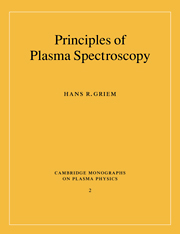Book contents
- Frontmatter
- Contents
- Preface
- Symbols
- 1 Classical theory of radiation
- 2 Quantum theory of radiation
- 3 Oscillator and line strengths
- 4 Spectral line broadening
- 5 Continuous spectra
- 6 Cross sections and level kinetics
- 7 Thermodynamic equilibrium relations
- 8 Radiative energy transfer
- 9 Radiation losses
- 10 Spectroscopic density measurements
- 11 Spectroscopic temperature measurements
- 12 Other diagnostic applications of plasma spectroscopy
- References
- Index
11 - Spectroscopic temperature measurements
Published online by Cambridge University Press: 29 August 2009
- Frontmatter
- Contents
- Preface
- Symbols
- 1 Classical theory of radiation
- 2 Quantum theory of radiation
- 3 Oscillator and line strengths
- 4 Spectral line broadening
- 5 Continuous spectra
- 6 Cross sections and level kinetics
- 7 Thermodynamic equilibrium relations
- 8 Radiative energy transfer
- 9 Radiation losses
- 10 Spectroscopic density measurements
- 11 Spectroscopic temperature measurements
- 12 Other diagnostic applications of plasma spectroscopy
- References
- Index
Summary
Next to the qualitative determination of the chemical composition of a plasma from emission and absorption line identifications, the measurement of electron and ion or atom temperatures is the oldest application of spectroscopic methods to plasma and gaseous electrical discharge physics, not to mention astronomy. It continues to play an important role, e.g., in fusion research (DeMichelis and Mattioli 1981, 1984 and Kauffman 1991). In the laboratory, independent methods based on laser light scattering and Langmuir probes are available, as already mentioned in the introduction to the preceding chapter. However, in astronomy spectroscopic methods normally must stand alone. Another important distinction is the usually dominant role of radiative transfer (see chapter 8) in astronomical applications, compared with the relatively small optical depth in some useful portion of the spectrum of most laboratory plasmas.
In many cases, it is necessary to distinguish between kinetic temperatures of electrons, ions and atoms, say, Te, Tz, and Ta. These temperatures may differ from each other even if the individual velocity distributions are close to Maxwellians, because, e.g., electron-electron energy transfer rates are much larger than electron-ion collision rates, as are ion-ion rates (Spitzer 1962). In most applications, at least the electrons do have a Maxwellian distribution, and we will assume this here.
- Type
- Chapter
- Information
- Principles of Plasma Spectroscopy , pp. 279 - 299Publisher: Cambridge University PressPrint publication year: 1997
- 9
- Cited by



